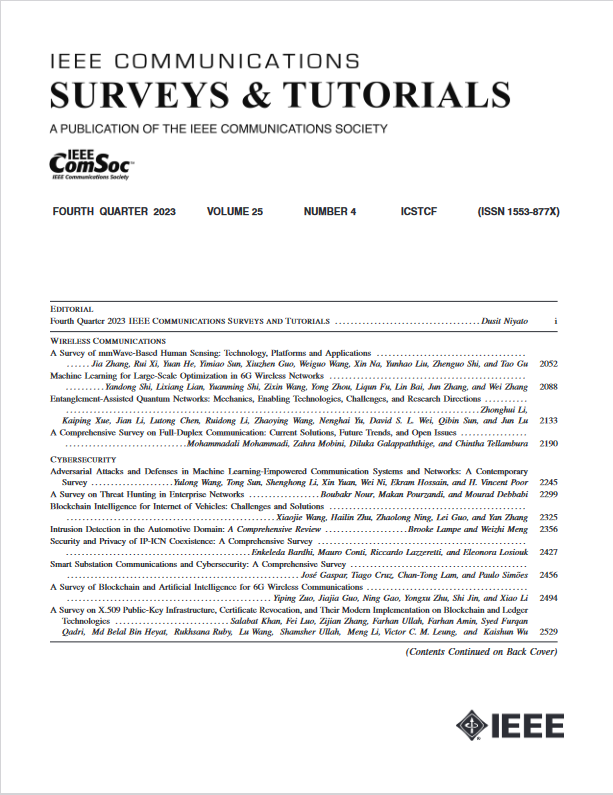Machine Learning-Aided Operations and Communications of Unmanned Aerial Vehicles: A Contemporary Survey
IF 34.4
1区 计算机科学
Q1 COMPUTER SCIENCE, INFORMATION SYSTEMS
引用次数: 0
Abstract
Over the past decade, Unmanned Aerial Vehicles (UAVs) have provided pervasive, efficient, and cost-effective solutions for data collection and communications. Their excellent mobility, flexibility, and fast deployment enable UAVs to be extensively utilized in agriculture, medical, rescue missions, smart cities, and intelligent transportation systems. Machine learning (ML) has been increasingly demonstrating its capability of improving the automation and operation precision of UAVs and many UAV-assisted applications, such as communications, sensing, and data collection. The ongoing amalgamation of UAV and ML techniques is creating a significant synergy and empowering UAVs with unprecedented intelligence and autonomy. This survey aims to provide a timely and comprehensive overview of ML techniques used in UAV operations and communications and identify the potential growth areas and research gaps. We emphasize the four key components of UAV operations and communications to which ML can significantly contribute, namely, perception and feature extraction, feature interpretation and regeneration, trajectory and mission planning, and aerodynamic control and operation. We classify the latest popular ML tools based on their applications to the four components and conduct gap analyses. This survey also takes a step forward by pointing out significant challenges in the upcoming realm of ML-aided automated UAV operations and communications. It is revealed that different ML techniques dominate the applications to the four key modules of UAV operations and communications. While there is an increasing trend of cross-module designs, little effort has been devoted to an end-to-end ML framework, from perception and feature extraction to aerodynamic control and operation. It is also unveiled that the reliability and trust of ML in UAV operations and applications require significant attention before full automation of UAVs and potential cooperation between UAVs and humans come to fruition.无人驾驶飞行器的机器学习辅助操作和通信:当代调查
过去十年来,无人飞行器(UAV)为数据收集和通信提供了普遍、高效和经济的解决方案。无人机具有出色的机动性、灵活性和快速部署能力,因此被广泛应用于农业、医疗、救援任务、智能城市和智能交通系统。机器学习(ML)在提高无人机的自动化程度和操作精度以及许多无人机辅助应用(如通信、传感和数据收集)方面的能力已日益显现。无人机和人工智能技术的不断融合正在产生巨大的协同效应,并赋予无人机前所未有的智能和自主性。本调查旨在及时、全面地概述无人机操作和通信中使用的 ML 技术,并确定潜在的增长领域和研究缺口。我们强调了人工智能可为无人机操作和通信做出重大贡献的四个关键组成部分,即感知和特征提取、特征解读和再生、轨迹和任务规划以及空气动力控制和操作。我们根据最新流行的人工智能工具在这四个方面的应用对其进行了分类,并进行了差距分析。这项调查还向前迈出了一步,指出了即将到来的人工智能辅助无人机自动操作和通信领域的重大挑战。调查显示,不同的 ML 技术在无人机操作和通信的四个关键模块的应用中占据主导地位。虽然跨模块设计的趋势日益明显,但从感知和特征提取到气动控制和操作,端到端的 ML 框架却鲜有问世。研究还表明,在实现无人机的全面自动化以及无人机与人类之间的潜在合作之前,需要高度重视人工智能在无人机操作和应用中的可靠性和可信度。
本文章由计算机程序翻译,如有差异,请以英文原文为准。
求助全文
约1分钟内获得全文
求助全文
来源期刊

IEEE Communications Surveys and Tutorials
COMPUTER SCIENCE, INFORMATION SYSTEMS-TELECOMMUNICATIONS
CiteScore
80.20
自引率
2.50%
发文量
84
审稿时长
6 months
期刊介绍:
IEEE Communications Surveys & Tutorials is an online journal published by the IEEE Communications Society for tutorials and surveys covering all aspects of the communications field. Telecommunications technology is progressing at a rapid pace, and the IEEE Communications Society is committed to providing researchers and other professionals the information and tools to stay abreast. IEEE Communications Surveys and Tutorials focuses on integrating and adding understanding to the existing literature on communications, putting results in context. Whether searching for in-depth information about a familiar area or an introduction into a new area, IEEE Communications Surveys & Tutorials aims to be the premier source of peer-reviewed, comprehensive tutorials and surveys, and pointers to further sources. IEEE Communications Surveys & Tutorials publishes only articles exclusively written for IEEE Communications Surveys & Tutorials and go through a rigorous review process before their publication in the quarterly issues.
A tutorial article in the IEEE Communications Surveys & Tutorials should be designed to help the reader to become familiar with and learn something specific about a chosen topic. In contrast, the term survey, as applied here, is defined to mean a survey of the literature. A survey article in IEEE Communications Surveys & Tutorials should provide a comprehensive review of developments in a selected area, covering its development from its inception to its current state and beyond, and illustrating its development through liberal citations from the literature. Both tutorials and surveys should be tutorial in nature and should be written in a style comprehensible to readers outside the specialty of the article.
 求助内容:
求助内容: 应助结果提醒方式:
应助结果提醒方式:


